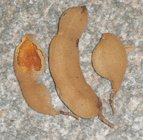Selection and storage

|
| Tamarind pods. Note brown, tart yet sweet-flavored pulp enclosed inside hard shell. |
Fresh tamarind is readily available in the markets by late spring and early summer. However, processed tamarinds such as compressed
tamarind blocks, ready-to-use slices, paste, concentrates, balls, etc., can be more readily available around the year in condiment stores and spice markets.
Choose fresh unbroken pods packed in boxes. If you are purchasing a processed form, buy the product from a well-reputed authentic brand. Avoid old, desiccated pulp, or off-smelling products.
Once at home store the pods or pulp inside the refrigerator where it will stay fresh for several months.
Culinary uses
 |
| Tamarind and chili pavlova. Courtesy: Rc |
Delicately sweet and sour, tamarind is one of the most sought-after ingredients in Indian, Middle Eastern, and Southeast Asian cooking. In some Indian households, its pods are cut open, and fresh pulp is used as and when required. Tamarind beans are struck with a “wooden stick” (kept at home, especially for the same purpose), and seeds are then manually removed. One may also use a paring knife to separate seeds from pulp.
To use as a condiment, a small portion of the pulp is soaked in half a cup of warm water for about 10 minutes. Swirl the pulp with your fingers so that it is dissolved evenly in water to prepare a thin sauce. Strain the juice through a filter or thin cloth sieve before using it in cooking.
Here are some serving tips:
-
Tamarind is a common ingredient all over India and South-East Asia in curries, “rasam,” chutneys, as well as in vegetable and lentil recipes.
-
The pulp is also favored in “hot and sour” soups as well in marinades.
-
The juice made of tamarind pulp with the addition of dates, sugar, honey, cardamom, cloves,
and coriander seeds are a refreshing drink marketed in different parts of the world. -
Its pulp is also employed in confectionaries as a solidifying agent.
Safety profile
Tamarind has no known reported cases of allergy or toxicity and may be safely used in pregnancy and nursing mothers.
(Medical Disclaimer: The information and reference guides on this website are intended
solely for the general information of the reader. It is not to be used to diagnose health problems or for treatment purposes. It is not a
substitute for medical care provided by a licensed and qualified health professional. Please consult your health care provider for any advice
on medications.)
≺≺ Back to Spices from Tamarind. Visit here for an impressive list of healthy spices with complete illustrations of their nutrition facts and health benefits.
≺≺ Back to Home page.
Further reading:
-
USDA National Nutrient Database. (opens in new window)
-
Gernot-Katzer’s spice pages. (Opens in new window).

